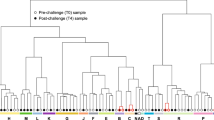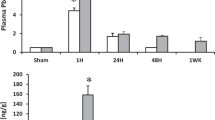Abstract
Mercury (Hg) is a widespread contaminant that has been shown to induce a wide range of adverse health effects in birds including reproductive, physiological and neurological impairments. Here we explored the relationship between blood total Hg concentrations ([THg]) and oxidative stress gene induction in the aquatic piscivorous Double-crested Cormorants (Phalacrocorax auritus) using a non-lethal technique, i.e., blood gene expression analysis. P. auritus blood was sampled at five sites across the Great Lakes basin, Ontario, Canada and was analyzed for [THg]. To assess cellular stress, the expression of glutathione peroxidases 1 and 3 (GPX1, GPX3), superoxide dismutase 1 (SOD1), heat-shock protein 70 kd-8 (HSP70-8) and glutathione S-transferase µ3 (GSTM3) were measured in whole blood samples using real-time RT-PCR. Results showed a significantly positive correlation between female blood [THg] and both GPX3 and GSTM3 expression. Different levels of oxidative stress experienced by males and females during the breeding season may be influencing the differential oxidative stress responses to blood [THg] observed in this study. Overall, these results suggest that Hg may lead to oxidative stress as some of the cellular stress-related genes were altered in the blood of female P. auritus and that blood gene expression analysis is a successful approach to assess bird health condition.





Similar content being viewed by others
References
Alonso-Álvarez C, Bertrand S, Godefroy D, Prost J, Faivre B, Chastel O, Sorci G (2006) An experimental manipulation of life-history trajectories and resistance to oxidative stress. Evolution 60(9):1913–1924
Alonso-Álvarez C, Pérez-Rodríguez L, García JT, Viñuela J, Mateo R (2010) Age and breeding effort as sources of individual variability in oxidative stress markers in a bird species. Physiol Biochem Zool 83:110–118
Bauman JW, Liu J, Klaassen CD (1993) Production of metallothionein and heat-shock proteins in response to metals. Fundam Appl Toxicol 21:15–22
Biard C, Surai PF, Møller AP (2005) Effects of carotenoid availability during laying on reproduction in the blue tit. Oecologia 144:32–44
Brambila E, Liu J, Morgan DL, Beliles RP, Waalkes MP (2002) Effec of mercury vapor exposure on metallothionein and glutathione S-transferase gene expression in the kidney of nonpregnant, pregnant and neonatal rats. J Toxicol Environ Health A 65:1273–1288
Burger J, Gochfeld M (2004) Marine birds as sentinels of environmental pollution. EcoHealth 1:263–274
Cambier S, Gonzalez P, Mesmer-Dudons N, Brèthes D, Fujimura M, Bourdineaud J (2012) Effects of dietary methylmercury on the zebrafish brain: histological, mitochondrial, and gene transcription analyses. Biometals 25:165–180
Casagrande S, Dell’Omo G, Costantini D, Tagliavini J, Groothuis T (2011) Variation of a carotenoid-based trait in relation to oxidative stress and endocrine status during the breeding season in the Eurasian kestrel: a multi-factorial study. Comp Biochem Physiol, Part A 160:16–26
Chomczynski P (2006) The single-step method of RNA isolation by acid guanidinium thiocyanate-phenol-chloroform extraction: twenty-something years on. Nat Protoc 1:581–585
Clausing P, Riedel B, Gericke S, Grun G, Muller L (1984) Differences in the distribution of methyl mercury in erythrocytes, plasma, and brain of Japanese quails and rats after a single oral dose. Arch Toxicol 156:132–135
Dar I, Barzilai A (2009) Cellular responses to oxidative stress. The DNA damage response: implications on cancer formation and treatment. Springer, Dordrecht, pp 65–79
Depew DC, Basu N, Burgess NM, Campbell LM, Evers DC, Grasman KA, Scheuhammer AM (2012) Derivation of screening benchmarks for dietary methylmercury exposure for the common loon (Gavia immer): rationale for use in ecological risk assessment. Environ Toxicol Chem 31:2399–2407
Dierickx PJ (1985) In vitro interaction of organic mercury compounds with soluble glutathione S-transferases from rat liver. Pharmacol Res Commun 17:489–500
Espinoza HM, Williams CR, Gallagher EP (2012) Effect of cadmium on glutathione S-transferase and metallothionein gene expression in Coho salmon liver, gill and olfactory tissues. Aquat Toxicol 110–111:37–44
Evers DC, Major A, Munney K, Mower BF, Vogel HS, Schoch N, Pokras M, Goodale MW, Fair J, Savoy LJ, DeSorbo CR, Yates DE, Hanson W, Taylor KM, Siegel LS, Cooley JH Jr, Bank MS (2008) Adverse effects from environmental mercury loads on breeding common loons. Ecotoxicol 17:69–81
Farina M, Campos F, Vendrell I, Berenguer J, Barzi M, Pons S, Suñol C (2009) Probucol increases glutathione peroxidase-1 activity and displays long-lasting protection against methylmercury toxicity in cerebellar granule cells. Toxicol Sci 112:416–426
Farina M, Aschner M, Rocha JBT (2011) Oxidative stress in MeHg-induced neurotoxicity. Toxicol Appl Pharmacol 256:405–417
Finley MT, Stendell RC (1978) Survival and reproductive success of black ducks fed methyl mercury. Environ Pollut 16:51–64
Franco JL, Farina M, Posser T, Dunkley PR, Dickson PW, Mattos JJ, Martins R, Bainy ACD, Marques MR, Dafre AL (2009) Methylmercury neurotoxicity is associated with inhibition of the antioxidant enzyme glutathione peroxidase. Free Radic Biol Med 47:449–457
Fridolfsson A, Ellegren H (1999) A simple and universal method for molecular sexing of non-ratite birds. J Avian Biol 30:116–121
Gad SC (2005a) Metallothionein. In: Wexler P (ed) Encyclopedia of toxicology, Second edn. Elsevier, New York, pp 48–49
Gad SC (2005b) Glutathione. In: Wexler P (ed) Encyclopedia of toxicology, Second edn. Elsevier, New York, p 446
Goodale MW, Evers DC, Mierzykowski SE, Bond AL, Burgess NM, Otorowski CI, Welch LJ, Hall CS, Ellis JC, Allen RB, Diamond AW, Kress SW, Taylor RJ (2008) Marine foraging birds as bioindicators of mercury in the Gulf of Maine. EcoHealth 5:409–425
Goodrich JM, Basu N (2012) Variants of glutathione S- transferase pi 1 exhibit differential enzymatic activity and inhibition by heavy metals. Toxicol In Vitro 26(4):630–635
Hassan ZK, Elobeid MA, Virk P, Omer SA, ElAmin M, Daghestani MH, AlOlayan EM (2012) Bisphenol a induces hepatotoxicity through oxidative stress in rat model. Oxid Med Cell Longev 2012:1–6
Hatch, JJ, Weseloh, DV (1999) Double-crested cormorant (Phalacrocorax auritus). In: Poole A (ed) Birds of North America Online. Cornell Lab of Ornithology, Ithaca. http://bna.birds.cornell.edu/bna/species/441. Accessed 25 March 2014
Heiss RS, Schoech SJ (2012) Oxidative cost of reproduction is sex specific and correlated with reproductive effort in a cooperatively breeding bird, the Florida scrub jay. Physiol Biochem Zool 85(5):499–503
Henny CJ, Hill EF, Hoffman DJ, Spalding MG, Grove RA (2002) Nineteenth century mercury: hazard to wading birds and cormorants of the Carson River, Nevada. Ecotoxicol 11:213–231
Jenko K, Karouna-Renier NK, Hoffman DJ (2012) Gene expression, glutathione status, and indicators of hepatic oxidative stress in laughing gull (Larus atricilla) hatchlings exposed to methylmercury. Environ Toxicol Chem 31:2588–2596
Kenow K, Hoffman DJ, Hines RK, Meyer MW, Bickham JW, Matson CW, Stebbins KR, Montagna P, Elfessi A (2008) Effects of methylmercury exposure on glutathione metabolism, oxidative stress, and chromosomal damage in captive-reared common loon (Gavia immer) chicks. Environ Pollut 156:732–738
Kim M, Park K, Park J, Kwak I (2013) Heavy metal contamination and metallothionein mRNA in blood and feathers of black-tailed gulls (Larus crassirostris) from South Korea. Environ Monit Assess 185:2221–2230
Krinsky NI (1989) Antioxidant functions of carotenoids. Free Radic Biol Med 7:617–635
Kumagai Y, HommaTakeda S, Shinyashiki M, Shimojo N (1997) Alterations in superoxide dismutase isozymes by methylmercury. Appl Organomet Chem 11:635–643
Langlois VS, Duarte-Guterman P, Ing S, Pauli BD, Cooke GM, Trudeau VL (2010) Fadrozole and finasteride exposures modulate sex steroid- and thyroid hormone-related gene expression in Silurana (Xenopus) tropicalis early larval development. Gen Comp Endocrinol 166:417–427
Lavoie RA, Hebert CE, Rail J, Braune BM, Yumvihoze E, Hill LG, Lean DRS (2010) Trophic structure and mercury distribution in a Gulf of St Lawrence (Canada) food web using stable isotope analysis. Sci Total Environ 408:5529–5539
Lucia M, Bocher P, Cosson RP, Churlaud C, Robin F, Bustamante P (2012) Insight on trace element detoxification in the black-tailed godwit (Limosa limosa) through genetic, enzymatic and metallothionein analyses. Sci Total Environ 423:73–83
Martindale JL, Holbrook NJ (2002) Cellular response to oxidative stress: signaling for suicide and survival. J Cell Physiol 192:1–15
Monson B, Staples D, Bhavsar S, Holsen T, Schrank C, Moses S, McGoldrick D, Backus S, Williams K (2011) Spatiotemporal trends of mercury in walleye and largemouth bass from the Laurentian Great Lakes Region. Ecotoxicol 20:1555–1567
Nakayama K, Iwata H, Kim E, Tashiro K, Tanabe S (2006) Gene expression profiling in common cormorant liver with an oligo array: assessing the potential toxic effects of environmental contaminants. Environ Sci Technol 40:1076–1083
Nakayama K, Iwata H, Tao L, Kannan K, Imoto M, Kim E, Tashiro K, Tanabe S (2008) Potential effects of perfluorinated compounds in common cormorants from Lake Biwa, Japan: an implication from the hepatic gene expression profiles by microarray. Environ Toxicol Chem 27:2378–2386
Puerto M, Jos A, Pichardo S, Gutiérrez-Praena D, Cameán AM (2011) Acute effects of pure cylindrospermopsin on the activity and transcription of antioxidant enzymes in tilapia (Oreochromis niloticus) exposed by gavage. Ecotoxicol 20:1852–1860
Rhee J, Lee Y, Lee J, Hwang D, Won E, Raisuddin S, Shin K (2007) Molecular cloning, expression, biochemical characteristics, and biomarker potential of theta class glutathione S-transferase (GST-T) from the polychaete Neanthes succinea. Aquat Toxicol 83:104–115
Robinson SA, Lajeunesse MJ, Forbes MR (2012) Sex differences in mercury contamination of birds: testing multiple hypotheses with meta-analysis. Environ Sci Technol 46:7094–7101
Rodnan GP, Ebaugh FG Jr, Fox MRS, Chambers DM (1957) The life span of the red blood cell and the red blood cell volume in the chicken, pigeon and duck as estimated by the use of Na2Cr51O4: with observations on red cell turnover rate in the mammal, bird and reptile. Blood 12:355
Rubolini D, Colombo G, Ambrosini R, Caprioli M, Clerici M, Colombo R, Dalle-Donne I, Milzani A, Romano A, Romano M, Saino N (2012) Sex-related effects of reproduction on biomarkers of oxidative damage in free-living barn swallows (Hirundo rustica). PLoS ONE 7(11):e48955. doi:10.1371/journl.pone.0048955
Sambrook J, Russell DW (2001) Molecular Cloning: a Laboratory Manual. Cold Spring Harbor Laboratory Press, Cold Spring Harbor, New York
Scheuhammer AM, Meyer MW (2007) Effects of environmental methylmercury on the health of wild birds, mammals, and fish. Ambio 36:12–18
Schmidt EMdS, AC Paulillo, Dittrich RL, Santin E, Beltrame O, Moura J, Oliveira EGd (2007) Serum biochemical parameters in the ring-necked pheasant (Phasianus colchicus) on breeding season. Int J Poult Sci 6:673–674
Spalding MG, Frederick PC, McGill HC, Bouton SN, McDowell LR (2000) Methylmercury accumulation in tissues and its effects on growth and appetite in captive great egrets. J Wildl Dis 36:411–422
Tummeleht L, Mägi M, Kilgas P, Mänd R, Hõrak P (2006) Antioxidant protection and plasma carotenoids of incubating great tits (Parus major L) in relation to health state and breeding conditions. Comp Biochem Physiol C Toxicol Pharmacol CBP 144:166–172
US EPA (2002) Method 1631, revision E: Mercury in water by oxidation, purge, and trap, and cold vapor atomic fluorescence spectrometry. US Environmental Protection Agency Office of Water EPA-821-R-02-019
Wolfe M, Schwarzbach S, Sulaiman R (1998) Effects of mercury on wildlife: a comprehensive review. Environ Toxicol Chem 17:146–160
Yee S, Choi BH (1994) Methylmercury poisoning induces oxidative stress in the mouse brain. Exp Mol Pathol 60:188–196
Zavalaga CB, Taylor SA, Dell’omo G, Anderson DJ, Friesen VL (2009) Male/female classification of the Peruvian booby. Wilson J Ornithol 121:739–744
Acknowledgments
The authors would like to thank A. Siew and A. Maclean for primer optimization. We also thank J. Cox, S. de Solla, D. Tyerman, B. Hickey and S. Belfry for advice and assistance in the field, as well as S. Wallace and E. Chown for assistance with bird sexing. This study was funded by two Discovery Grants from the Natural Sciences and Engineering Research Council (NSERC) of Canada to VSL and LMC, an NSERC-CGS(D) to RAL and an NSERC-USRA to LAG.
Conflict of interest
The authors declare that they have no conflict of interest.
Author information
Authors and Affiliations
Corresponding author
Rights and permissions
About this article
Cite this article
Gibson, L.A., Lavoie, R.A., Bissegger, S. et al. A positive correlation between mercury and oxidative stress-related gene expression (GPX3 and GSTM3) is measured in female Double-crested Cormorant blood. Ecotoxicology 23, 1004–1014 (2014). https://doi.org/10.1007/s10646-014-1243-5
Accepted:
Published:
Issue Date:
DOI: https://doi.org/10.1007/s10646-014-1243-5




